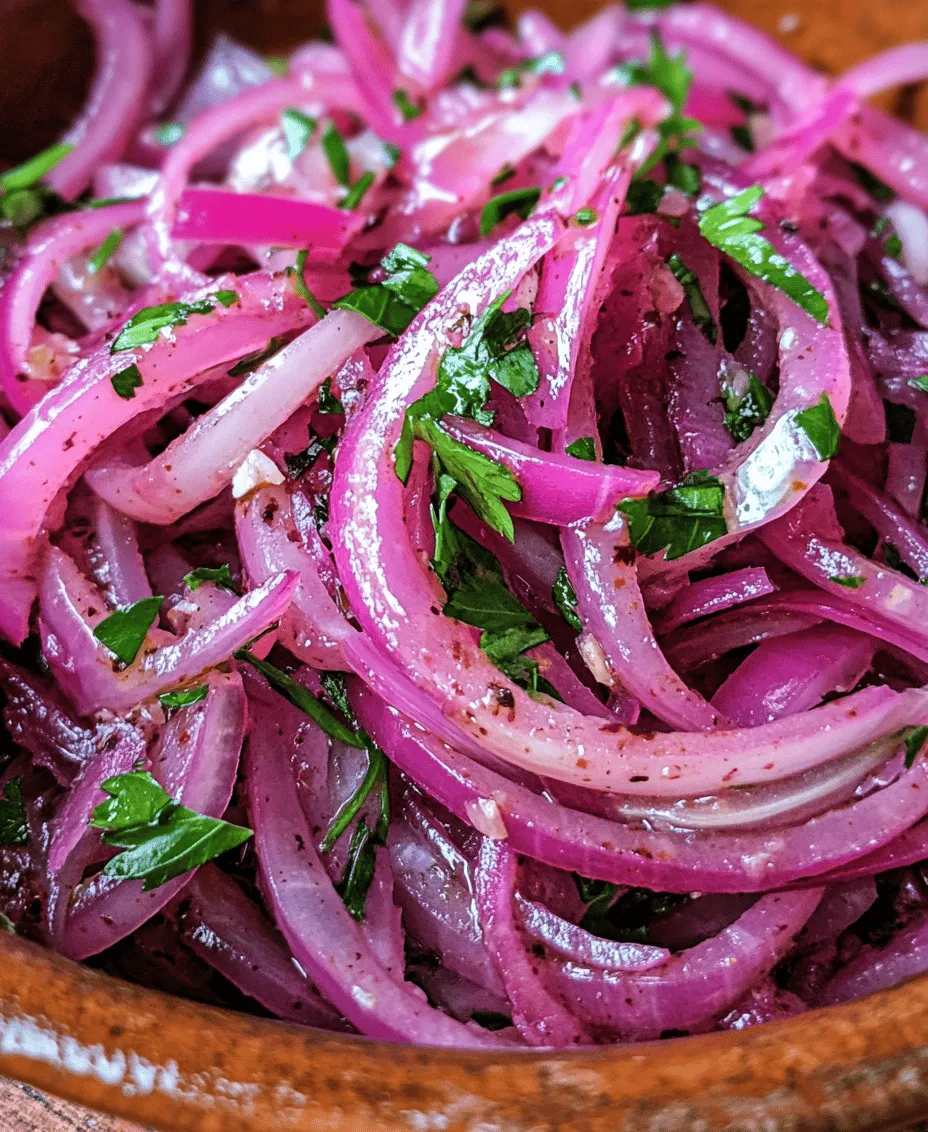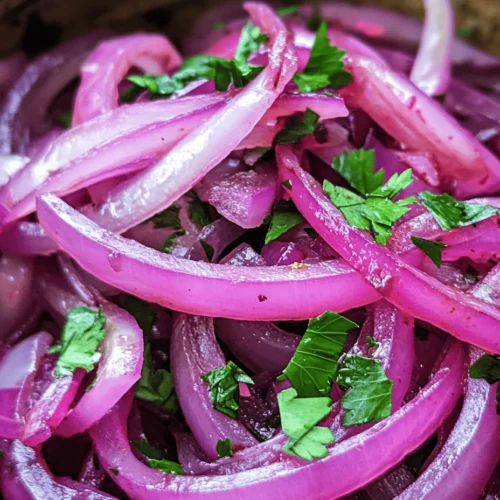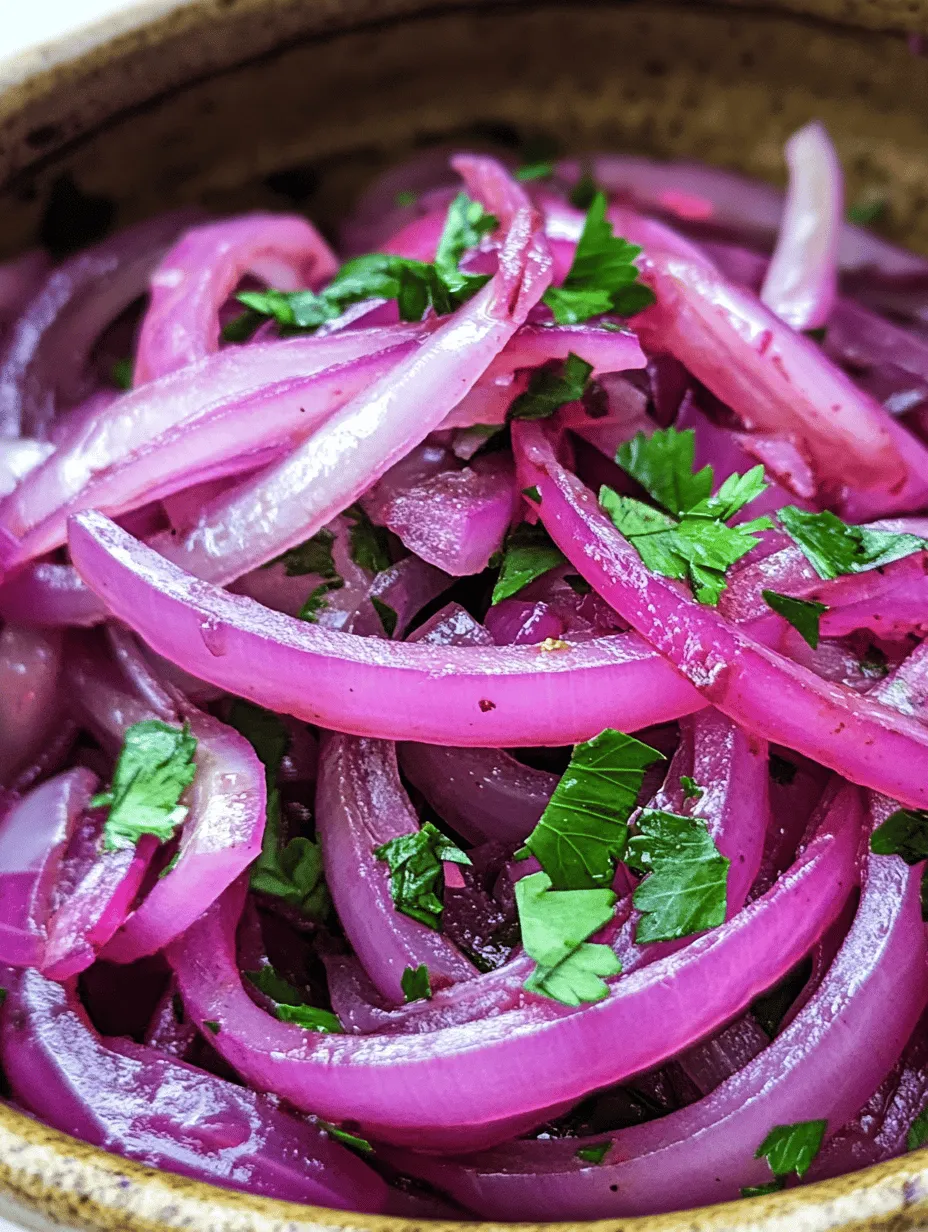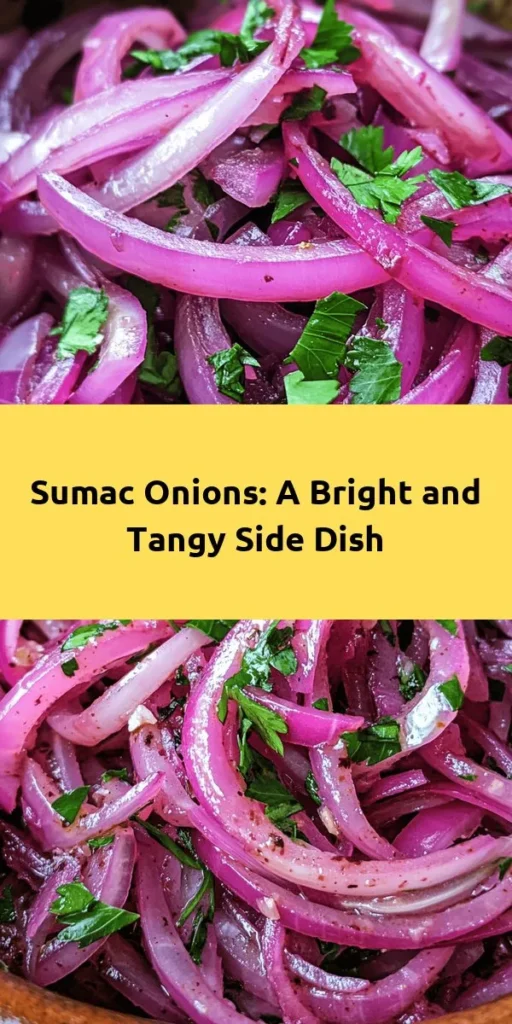Introduction
If you’re seeking a fresh, zesty side dish that can elevate any meal, look no further than Sumac Onions Delight. This simple yet remarkable recipe highlights the vibrant flavors of red onions enhanced by the tangy notes of sumac, making it a perfect companion for grilled meats, salads, or even as a topping for sandwiches. The beauty of this dish lies in its versatility; it can be served alongside hearty entrees or enjoyed on its own as a refreshing snack.
Rooted in Middle Eastern cuisine, sumac has been a beloved ingredient for centuries, cherished for its unique flavor and vibrant color. This recipe not only showcases sumac’s culinary appeal but also demonstrates how a few basic ingredients can come together to create something extraordinary. Join us as we explore the cultural significance of sumac, the benefits it brings to your health and cooking, and the step-by-step instructions to prepare this delightful dish.
Understanding Sumac and Its Benefits
Definition and Origin of Sumac
Sumac is a spice derived from the dried and ground berries of the sumac plant, which belongs to the Anacardiaceae family. These red berries are primarily found in the Mediterranean region, North Africa, and parts of the Middle East. Traditionally, sumac has been used not only as a culinary ingredient but also in medicinal practices due to its various health benefits. Its tangy, lemon-like flavor makes it a sought-after seasoning in many regional dishes, from salads to marinades.
Nutritional Benefits of Sumac
Beyond its culinary uses, sumac is packed with health benefits. It is rich in antioxidants, which help combat oxidative stress in the body. These antioxidants can contribute to overall health by reducing inflammation and supporting the immune system. Additionally, sumac has anti-inflammatory properties, which can be beneficial for those suffering from conditions such as arthritis. Incorporating sumac into your diet can be an easy way to boost your antioxidant intake while adding a flavorful twist to your meals.
How Sumac Enhances Flavor Profiles in Cooking
Sumac’s unique tartness adds a refreshing acidity that can elevate a dish’s flavor profile without overpowering other ingredients. It serves as a perfect counterbalance to rich or fatty foods, making it an excellent seasoning for grilled meats, roasted vegetables, and even creamy dips. Unlike vinegar or lemon juice, which can sometimes overwhelm a dish, sumac offers a subtler tang that enhances rather than masks the natural flavors of the ingredients.
Comparison with Other Spices and Its Unique Characteristics
When compared to other tangy spices, such as lemon zest or tamarind, sumac stands out for its distinctive flavor and versatility. Lemon zest provides brightness but lacks the depth of flavor that sumac brings. Tamarind, while sour, carries a more complex sweetness that can alter the intended profile of a dish. Sumac, on the other hand, is a versatile spice that can be used in both savory and sweet applications, making it a must-have in any spice collection.
Ingredients Breakdown
To make Sumac Onions Delight, you only need a handful of ingredients, each contributing uniquely to the dish’s overall flavor and texture. Here’s a detailed breakdown of what you’ll need:
Red Onions
Red onions are the star of this recipe, known for their mild flavor and vibrant color. They are not only visually appealing but also offer health benefits, including essential vitamins and antioxidants. When selecting red onions, look for those that are firm, heavy for their size, and free from blemishes. They should have a crisp texture, which is crucial for achieving the ideal crunch in your dish.
Olive Oil
Quality olive oil plays a significant role in this recipe. It adds richness and depth to the onions while also helping to soften their texture during cooking. Extra virgin olive oil is the best choice here, as it contains higher levels of antioxidants and healthy fats. When selecting olive oil, look for a cold-pressed variety with a robust flavor to enhance the overall taste of the dish.
Sumac
As the key ingredient, sumac is what makes this dish truly special. Its tart flavor pairs beautifully with the sweet notes of the red onions, creating a harmonious balance. Look for high-quality sumac that has a vibrant color and a fresh aroma. Avoid dull or faded varieties, as they may lack flavor and potency.
Salt and Black Pepper
Seasoning is crucial in any recipe, and Sumac Onions Delight is no exception. Salt enhances the natural flavors of the ingredients, while black pepper adds a subtle warmth and complexity. Use kosher salt for better distribution and control, and freshly cracked black pepper for the best flavor. The right balance of seasoning will elevate the taste of your onions, ensuring they shine in this dish.
Lemon Juice
Lemon juice adds a bright, acidic note that complements the sumac and balances the sweetness of the onions. Freshly squeezed lemon juice is recommended for its vibrant flavor and aroma. Avoid bottled lemon juice, as it often contains preservatives that can alter the taste of your dish. The acidity from the lemon juice will help to soften the onions further, creating a delightful texture.
Fresh Parsley
Finally, fresh parsley not only adds a pop of color but also brings a fresh, herbaceous note to the dish. It provides a lovely contrast to the tartness of the sumac and the sweetness of the onions. When choosing parsley, opt for vibrant green leaves that are free from wilting or browning. Chopped finely, parsley can elevate the presentation and flavor of the Sumac Onions Delight.
Step-by-Step Instructions
Now that we have a clear understanding of the ingredients and their significance, let’s dive into the preparation of Sumac Onions Delight. Follow these step-by-step instructions to create this refreshing dish:
Preparing the Onions
1. Slice the Onions: Begin by peeling the red onions and cutting them in half from root to tip. Place the cut side down on the cutting board and slice them thinly. Aim for uniform slices, about 1/8 inch thick. This ensures that the onions will cook evenly and maintain a pleasant crunch in the final dish.
2. Soak the Onions (Optional): To mellow the sharpness of the onions, you can soak them in cold water for about 10-15 minutes. This step is optional but recommended if you prefer a milder flavor. After soaking, drain the onions and pat them dry with a paper towel to remove excess moisture.
Importance of Slicing Technique for Texture and Flavor
The slicing technique is crucial for achieving the right texture in your Sumac Onions Delight. Thinly sliced onions will absorb the flavors of the sumac and seasonings more effectively, creating a harmonious blend of tastes. Additionally, uniform slices will cook evenly, ensuring that each bite has a consistent texture.
Seasoning the Onions
3. Combine Ingredients: In a mixing bowl, combine the sliced onions with a generous drizzle of extra virgin olive oil, a pinch of salt, and freshly cracked black pepper. The olive oil will not only enhance the flavor but also help to soften the onions, making them more palatable.
4. Add Sumac and Lemon Juice: Sprinkle the sumac over the onions, followed by a squeeze of fresh lemon juice. The amount of sumac can be adjusted based on your taste preferences, but a good starting point is about 1-2 tablespoons. Toss the ingredients together gently, ensuring the onions are evenly coated with the oil, sumac, and lemon juice.
Tips for Evenly Coating the Onions with the Mixture
To ensure that every onion slice is coated evenly with the seasoning, use your hands to gently massage the mixture into the onions. This will help to release their natural juices and allow the flavors to meld beautifully. Allow the mixture to sit for about 10 minutes before serving; this will let the acids from the lemon juice and sumac penetrate the onions, enhancing their flavor even further.
With the onions seasoned and ready, you are well on your way to creating a vibrant dish that will impress your guests and tantalize your taste buds. Stay tuned for the next part, where we will explore the serving suggestions, variations, and tips for making the most of your Sumac Onions Delight!

Marinating Process
To unlock the full potential of your Sumac Onions Delight, the marinating process is essential. Marinating the onions in a mixture of fresh lemon juice, sumac, and olive oil allows the flavors to meld beautifully, transforming the dish into a vibrant and zesty accompaniment to your meals. The acidity from the lemon juice helps to soften the onions, making them more palatable and enhancing their natural sweetness while the sumac adds a tart, lemony flavor that elevates the overall taste experience.
Why Marinating is Crucial for Flavor Development
Marinating is not merely a step in the preparation; it’s a crucial process that ensures the onions absorb the flavors of the marinade. The acids from the lemon juice penetrate the onion layers, allowing the sumac and spices to infuse each slice with intense flavor. This process also helps to mellow the rawness of the onions, making them a delightful and refreshing addition to any dish. By letting the onions sit in the marinade, you are ensuring that every bite bursts with flavor.
Ideal Marinating Time and Tips for Best Results
For optimal results, allow the onions to marinate for at least 30 minutes, but if time permits, aim for 1 to 2 hours. This gives the flavors time to develop and the onions to soften. If you’re preparing the dish ahead of time, marinating overnight in the refrigerator will yield even better results, as the flavors will deepen and the onions will become even more tender.
A few tips for marinating:
– Use Fresh Ingredients: Fresh lemon juice and high-quality olive oil make a significant difference in flavor.
– Mix Thoroughly: Ensure that every onion slice is coated in the marinade for even flavor distribution.
– Refrigerate: Always marinate in the refrigerator to prevent bacterial growth.
Serving Suggestions
Sumac Onions Delight is incredibly versatile and can be incorporated into a variety of meals, enhancing both flavor and presentation. Here are some creative ways to serve this dish:
Pairing Ideas with Grilled Meats, Salads, and Sandwiches
1. Grilled Meats: The bright acidity of the marinated onions complements grilled meats beautifully. Serve them alongside chicken, lamb, or beef kebabs for a refreshing contrast. The tartness of the sumac cuts through the richness of the meat, enhancing the overall dining experience.
2. Salads: Incorporate Sumac Onions Delight into mixed greens or grain salads. Toss them with ingredients like arugula, feta cheese, cherry tomatoes, and olives for a Mediterranean-inspired salad that’s bursting with flavor. The onions add a delightful crunch and tang that ties the dish together.
3. Sandwiches and Wraps: Elevate your sandwiches by adding a generous spoonful of marinated onions. They pair wonderfully with roasted vegetables, falafel, or grilled chicken, adding a refreshing twist to your lunchtime favorites.
Culinary Uses for Sumac Onions Delight
Beyond serving as a standalone side dish, Sumac Onions Delight can be used in several innovative ways:
Serving as a Refreshing Side Dish
This dish shines as a side, particularly in summer meals or barbecues. It provides a refreshing counterpoint to heavier dishes, balancing out flavors and adding a pop of color to your plate.
Ideal Toppings for Various Cuisines
Sumac Onions Delight can serve as an excellent topping for various cuisines. Use it on top of hummus, as a garnish for soups, or mixed into rice dishes. The tangy onions add depth and complexity to any dish, enhancing the overall flavor profile.
Incorporating into Mediterranean or Middle Eastern Meals
In Mediterranean and Middle Eastern cuisines, Sumac Onions Delight is a natural fit. Serve it alongside tabbouleh, grilled meats, or as part of a mezze platter. Its zesty flavor complements traditional dishes and adds a unique twist that will impress your guests.
Use in Salads for Added Flavor and Crunch
Add a scoop of Sumac Onions Delight to your salads for an unexpected burst of flavor. The crunch of the onions and the tanginess of the marinade will elevate simple green salads, grain salads, or even pasta salads, making them much more satisfying.
Nutritional Information
Sumac Onions Delight not only tantalizes the taste buds but also offers several nutritional benefits. Here’s a breakdown of its health benefits and macronutrients:
Overview of the Health Benefits of the Dish as a Whole
The primary ingredients in Sumac Onions Delight—onions and sumac—carry a range of health benefits. Onions are rich in vitamins C and B6, along with folate and potassium. They are known for their antioxidant properties, which can help fight inflammation and promote heart health.
Sumac, in addition to its unique flavor, is packed with antioxidants. It has been linked to various health benefits, including improved digestion and lower blood sugar levels. The combination of these ingredients makes for a nutritious side that can be enjoyed guilt-free.
Breakdown of Macronutrients
On average, a serving of Sumac Onions Delight (approximately 1/2 cup) contains:
– Calories: 70
– Fats: 5g (mostly from olive oil)
– Carbohydrates: 8g
– Proteins: 1g
This dish is relatively low in calories and fat, primarily due to the use of fresh ingredients. The olive oil contributes healthy fats, which are beneficial for heart health.
Antioxidant Properties and Digestive Benefits of the Ingredients
The antioxidants found in both onions and sumac can help reduce oxidative stress in the body, potentially lowering the risk of chronic diseases. Additionally, onions are known to promote healthy digestion due to their fiber content, while the acidity from sumac aids in the digestive process.
Cultural Context and Variations
Sumac has a rich history in various cuisines, particularly in the Middle East, where it is a staple spice. It has been used for centuries not only for its flavor but also for its medicinal properties. Understanding the cultural significance of sumac can deepen your appreciation of this dish.
Historical Use of Sumac in Different Cuisines
Sumac is commonly found in Middle Eastern dishes, often sprinkled on grilled meats or included in salads. Its tangy flavor enhances the taste of many foods, making it a beloved spice in various culinary traditions.
Variants of Onion Salads Across Cultures
Onion salads are enjoyed worldwide, with each culture adding its twist. For example, in Mexico, pickled onions are a popular condiment, while in Indian cuisine, onions are often mixed with tomatoes and herbs. The versatility of onions allows for endless variations that can be tailored to personal preferences.
Suggestions for Adapting the Recipe with Other Ingredients
Feel free to get creative with your Sumac Onions Delight. Consider adding diced tomatoes or cucumbers for added texture and flavor. Incorporating herbs like parsley or mint can also enhance the freshness of the dish. These variations provide a delightful way to customize the recipe to suit your taste.
Conclusion
Sumac Onions Delight is more than just a simple side dish; it’s a celebration of fresh ingredients and vibrant flavors. This recipe exemplifies the joy of cooking with minimal ingredients to create something truly delicious and satisfying. The ease of preparation makes it an accessible option for any home cook, whether you’re an experienced chef or a beginner.
The balance of flavors, health benefits, and cultural significance of this dish make it a wonderful addition to any meal. As you explore this recipe, allow yourself to enjoy the process of discovering new flavors and culinary traditions. Embrace the simplicity of fresh ingredients and let Sumac Onions Delight become a staple in your kitchen. Enjoy the journey of cooking and the delightful experience of sharing these vibrant flavors with family and friends.



